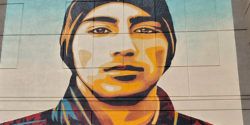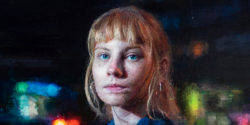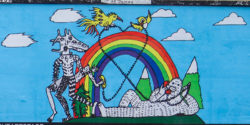
With every flashpoint on the cultural landscape it is important to give it voice and understand/consider its perspective. BSA hosted an important yet wide collection of perspectives addressing issues as varied as art, architecture, green energy, automatic traffic, art collecting, graffiti, Street Art, public art, kinetic sculpture, new cultural think tanks, new approaches to curation, and laboratories that facilitate greater interaction between art and people with the aid of new technologies. While some of the talks captured passersby whose interest was piqued enough for them to grab a seat, others were anticipated by many and filled the room before they began.
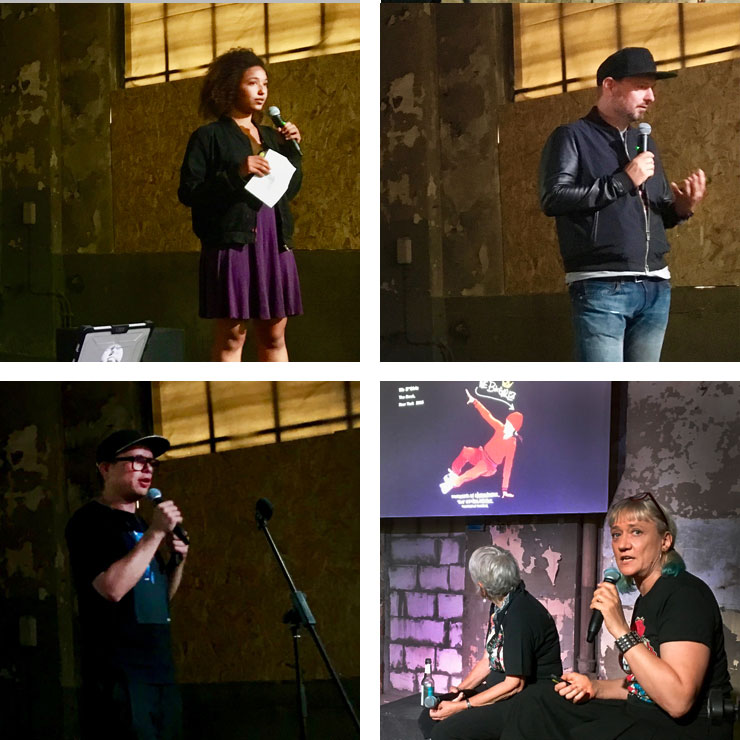
Left to right, top to bottom: Genefer Baxter, Marco Voight, Denis Leo Hegic, Martha Cooper, Nika Kramer
We were also pleased to host a few revered folks to give us all a perspective on the long game and how it is run – the heralded graffiti/Street Art photographer Martha Cooper and the famed member of the artist group Mülheimer Freiheit and the Junge Wilde (German for “wild youth”) movement, artist Hans Peter Adamski, who was joined onstage by Michel Victor Adamski, a lecturer, organizer of salons, and co-founder of the agency La Maison Victor Schilly & Friends. Each of them shared insights about their respective paths and held the audience in rapt attention. Cooper shared her stage with colleague and co-conspirator Nika Kramer, who showed images of her work in the B-Girl and B-Boy scene as well as her images working for the Urban Nation Museum of Urban Contemporary Art in Berlin.
With an exhibition theme of “Intelligence of Many” we continued to reiterate that our collective knowledge and intelligence is being raised now thanks to the digital transformation that societies and systems are undergoing – and a general flattening of traditional hierarchies. The presentations lead us in different directions for sure, but so did the conversations in the audience and with the speakers that were generated.
Other speakers included Isabel Bernheimer, the respected German gallerist (and Art Factory think tank founder) whose family has been dealing and collecting art for five generations – and her business angel Birgit Strobel, who volleyed questions to one another about how the modern gallery has to be responsive to social, political, and technological changes and the shifting priorities of the new generation of collectors that distinguish them from other buyers.
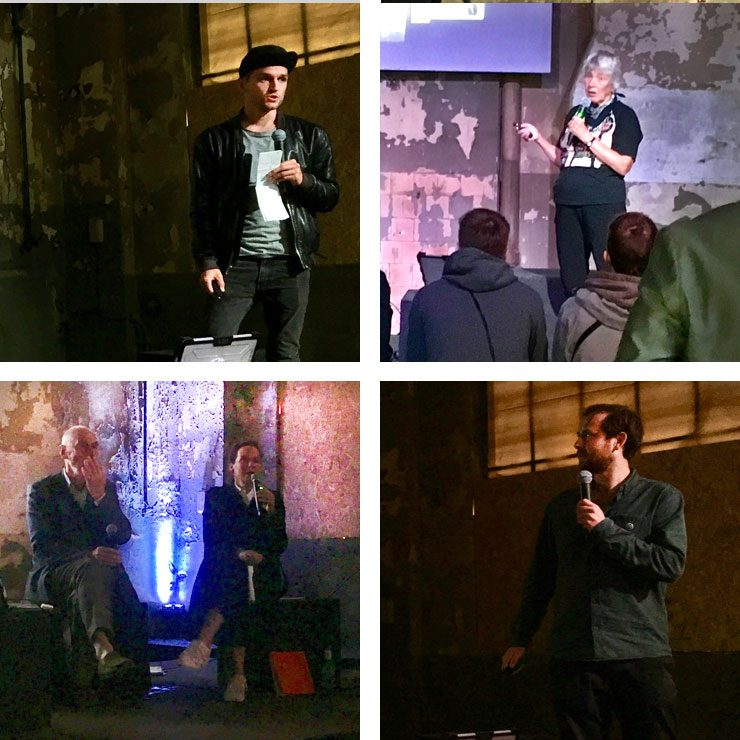
Left to right, top to bottom: Jeremy from Snøhetta, Martha Cooper, Hans Peter Adamski, Michele Victor Adamski, Silvan Engelmeir
Sasha Krolikova spoke about Eastern Block Street Artists, the formulas of traditional religious iconography, how they were used by the Mexican muralists, Leninist propaganda, and are being subverted now to talk about the emerging Precariot via neo-muralism – Precariat being a social class and generation across many countries of the so-called “developed world” who have been artfully engineered out of a social net. Christiane Arnscheidt spoke about the coming revolution of automatic traffic and her current involvement with the only entirely green fleet of car sharing in the world at CleverShuttle, an app-based service spreading from five German cities to 19 at the end of ’19. Speaking of green technology, journalist and CEO of Green Window talked about “future science” and environmental sustainability.
The new generation of curators spoke as well – Genefer Baxter spoke about co-founding IMRSV Arts and there work to make art exhibitions that people can interact with physically with the help of emerging responsive technologies, virtual, augmented, and mixed. Cultural Manager and curator Elisabetta Pejer spoke about founding laNori Art Management and the artists whom she is representing in the Urban Art scene. A foundational member of the team that built the new UN Museum for Urban Contemporary Art in Berlin, Pejer has curated the IMAGO exhibition currently running at the Munich Museum of Urban Contemporary Art that includes 31 international artists involved in the Street Art scene reinterpreting the portrait. A significant show that references the historical, geographical and a number of artistic movements in its interpretation of the traditional practice of portraiture. Michelle Houston talked about curation of shows like the successful “Wandelism” project in Berlin this year and how Street Art/Urban Art carries subtleties that compare and contrast with her perspective as a former Christie’s agent and while employed at the Victoria and Albert Museum.
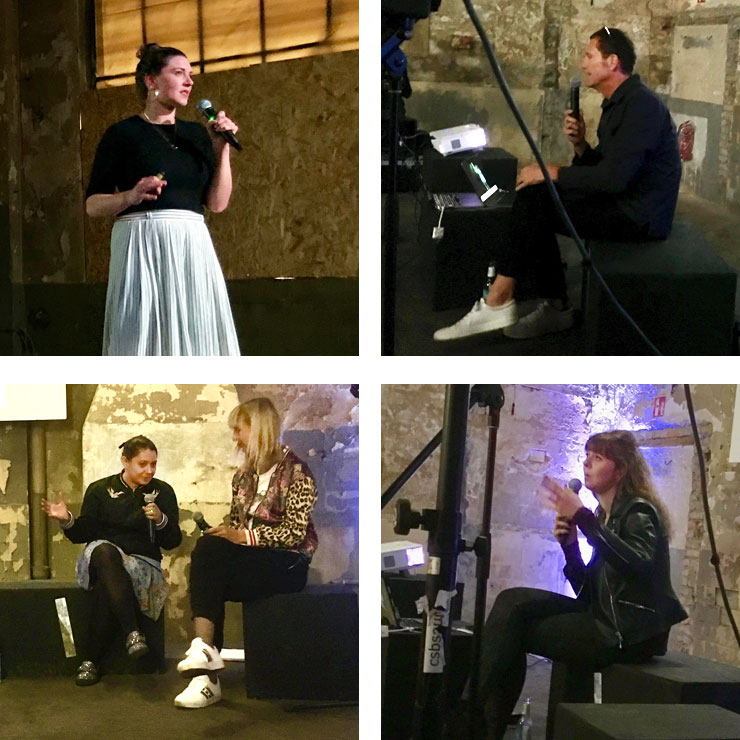
Left to right, top to bottom: Michele Houston, Joachim Sauter, Isabel Berneheimer, Birgit Strobel, and Elisabetta Pajer.
Real Estate developer Silvan Engelmeier spoke about his perspective on community involvement in the development decisions that go into projects that affect their neighborhoods, and Jeremy of Oslo/New York based Snøhetta architects gave insight into that firms team culture and progressive projects in private and public space. Kinetic sculptor Joachim Sauter blew people’s minds with his eerily fluid and complexly dancing large scale sculptures in public spaces, including on in the Singapore airport that endeavors to “slow” the behaviors of people who are there to catch their flight.
Finally we also heard from both of the co-curators of the Monumenta exhibit itself, the art historian Jan Fieldler who talked about “Space and Emotion” and the manipulating of the environment in art exhibitions while Denis Leo Hegic spoke to the need to democratize access to art, to eliminate obstacles and gate keepers, to access the intelligence of many when conceptualizing and creating exhibitions – a credo put to work at this show.
It was a total honor to steer this boat and to meet the Leipzig audiences, to hear the perspectives of the presenters, and to consider the state of Street Art, Urban Art, and public art somewhere and everywhere in the mix. Our sincere thanks to the tireless team of really thoughtful and hardworking people who have made Monumenta the culturally impactful show that it is.
 BROOKLYN STREET ART LOVES YOU MORE EVERY DAY
BROOKLYN STREET ART LOVES YOU MORE EVERY DAY




